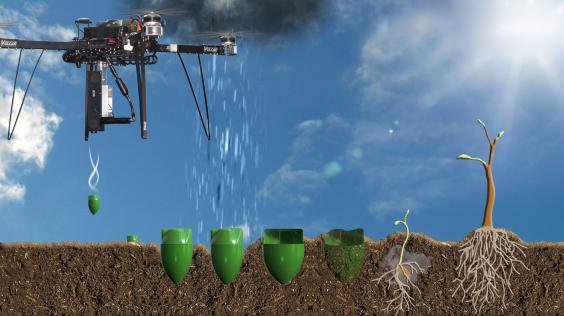Here, we have put together some innovations that have been developed to protect the environment from damages occasioned by climate change.
Tree planting drones
Trees are essential for storing greenhouse gas emissions, filtering air and water, nourishing soil, providing food and shelter, and fostering ecosystems.
Yet the world loses 18.3 million acres of forest each year, or 27 soccer fields worth of trees every minute, according to the World Wildlife Fund.
Planting seeds by hand always helps, but it’s hard for individuals to match the pace of industrial deforestation.
That’s why engineers across the world are coming up with high-tech solutions.
UK-based company BioCarbon is using drones to spray tree seeds throughout ravaged forests and claim they can plant 1 billion trees per year.
Mapping drones first determine the best planting strategy for a region, then planting drones hover six feet above the ground and fire seeds so fast that they get snugly implanted into the soil, according to National Geographic.
Palm Tree wind farms
Wind power is a largely underutilized resource.
In fact, a team of researchers found that a wind farm the size of Greenland in the Atlantic Ocean could generate enough energy to power all of humanity, essentially eliminating the need for fossil fuels.
That’s the theory, now putting it into practice is the hard part.
One group of engineers is trying to get there by building wind turbines that are more than twice as large as the biggest turbines in use today. The 650-foot blades would function like palm tree fronds by adapting to and bending with the speed and direction of the wind.
Methane leaks spotting Satellites
Around the world, leaks from fracking and other activities can emit staggering amounts of an invisible and odourless gas for months at a time before being detected.
That gas is methane and it traps up to 80 times as much heat as carbon.
A team of scientists is trying to send a satellite into space that can pinpoint when and where methane leaks take place so they can be plugged sooner rather than later.
If successful, the satellite will be able to reduce methane emissions from the oil and gas industry by as much as 50%.
Pumps to Cool Down Coral Reefs
Coral reefs are highly sensitive to heat increases, with two or three degree Celsius spikes posing an existential threat.
And as global warming intensifies, coral reefs around the world are dying wholesale.
One engineer named Mo Ehsani wants to provide relief to coral with an underwater pipe that can pump cold water onto reefs, cooling them down and preventing a process known as coral bleaching.
His idea is by no means a solution to the accelerating threat of climate change, but it could slow the decline of the world’s coral populations.
Plastic-Eating Enzymes
If current trends continue, 12 billion metric tons of plastic waste will exist in the world by 2050. That’s 1.6 metric tons, or the size of a midsize car, for every human on the planet.
All of this plastic is causing enormous harm to wildlife and potentially threatening human health by infiltrating the food and water we drink.
But a scientific breakthrough that came about by accident could change this dire development.
A team of researchers in Japan inadvertently developed an enzyme that can break down plastic in a matter of days — far faster than the hundreds of years that plastic usually takes to decompose.
Doing this “means we won’t need to dig up any more oil and, fundamentally, it should reduce the amount of plastic in the environment,” lead researcher, Professor John McGeehan of the University of Portsmouth, UK said.
Futuristic Solar Panels
Solar panels are traditionally installed on rooftops or in large fields to gather sunlight without obstruction.
But scientists are increasingly looking for new ways to harvest solar energy.
Recently developed solar panels in China harvest energy from raindrops, solar panel roads are being tested out, and a team of researchers at Michigan State University believe that all windows and cell phone screens could begin cultivating the sun’s energy.
Solar Geoengineering
The past four years have been the hottest ever recorded, and a recent report by US government agencies predicted that temperatures could rise by about as much as 7.5 degrees Fahrenheit (4.8 degrees Celsius) by the end of the century if current trends continue, which would cause catastrophic environmental changes.
Barring a radical reduction of global greenhouse gas emissions, researchers at Harvard are proposing to send sun-blocking particles into the air to cool the planet and stave off the worst consequences of climate change.
Read also: Study: Ocean warmth hits record high
It might sound like doomsday technology, but the same particles are released into the atmosphere by cars and factories, according to David Keith, a Harvard geoengineer who spoke with Global Citizen.
An intentional strategy to block the sun, he said, could help to buy some more time for countries to reduce their emissions — the only realistic way to avert climate change.
Genetic Modification
Climate change could eliminate crops as diverse and popular as coffee, chocolate, and corn because of the increased risk of drought, flooding, and pests in the years to come.
Genetic modification, meanwhile, could bolster crops against these disruptions by providing genes that are pest-resistant, drought-resistant, or can withstand saltwater intrusion from rising sea levels.
GMOs have been in use for many years now, but the controversy surrounding them has slowed their adoption around the world even though scientists have broadly accepted that GMOs are perfectly safe to consume.
This story was adapted from Global Citizen.
